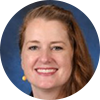In the early 20th century, efficiency became the focus of our industrializing society. Trying to find a way to do things faster and better quickly became the language of our country and affected every industry, including education. We are still striving to find the “one best way” to accomplish the task of education.
For me, the quest of “the one best way” is part of my family lore. My great-grandparents, Frank and Lillian Gilbreth, were efficiency experts. Finding the best way to accomplish a task, from taking a shower to cooking a meal, has always been part of the family conversation. Consider this anecdote about my great-grandfather, Frank:
Frank B. Gilbreth, the engineer who conceived the “Motion Study” Principles (techniques for manual productivity improvement) was met at the dock in London, England, by a friend, in 1911 … At the British-Japanese Exposition, he had observed Japanese girls, in their brilliant kimonos, wrapping cans of shoe polish in colorful wrappers. Their fingers were said to be flying like hummingbird wings. Crowds were standing by to watch their performance. The demonstration was to help the sales of Japanese shoe polish.
The friend, knowing Gilbreth’s zeal for applying his productivity-improving principles, took him from the dock, directly to the Exposition Hall, even before letting him register at his hotel. Casually walking and talking with his friend, Gilbreth stopped to view the shoe polish wrapping demonstration. The friend was anxious to see what Gilbreth would do. Gilbreth watched for a few moments, then simply said, “They are really skilled, but they could produce more.” He timed the fastest girl and without hesitation, ascended the platform. He found she was being paid on a piecework basis and said, “I’m going to tell you how to earn more money, but you must follow my instructions.” He changed the location of her supplies and showed her how to wrap and set aside more efficiently. He timed her again after several cycles. When he rejoined his friend he said, “When she gets the hang of it she’ll be making twice her former earnings.”
Improvements and Efficiency Models
As educational institutions, we often try to follow a path of improvement that looks like the efficiency models of my great-grandparents: watch the current practices and look for ways to fine-tune the system. But what if the system isn’t effective to begin with? What if our finely honed systems aren’t producing what we really desire? We often know “what” we want to produce. Christian schools often have some of the most elaborate and aspirational mission statements. But do we really know how to get there? Is what we are doing in the classroom really connected to those mission statements—or are we just learning to wrap the shoe polish faster?
Revolution of Change

In education, this pandemic season has only emphasized the fact that we are in a revolution of change. For Christian education, it is more important than ever that we are driven and focused on our mission, and that our daily practices are producing the desired result. Steven F. Butler’s new book, Moving Learning Forward in Christian Schools: A Practical Guide for a Missioned-Focused Curriculum, delivers a “how” that even small schools with fewer resources can embrace. Working with the “Understanding by Design” model formulated by Jay McTighe and the late Grant Wiggins, Butler’s book helps quantify the practices that can help a Christian school align their learning and teaching practices to their mission.
As a case study in Butler’s work, our small school had the opportunity to begin with the end in mind: we started with mission and outcomes, and we are continuing to incrementally redesign what we do in the classroom. Developing our capacity for systemic thinking and making a case for every program and practice is revitalizing our school and helping us focus our efforts. As Butler states, “Because the backward design process is foreign to many Christian school educators, this process is awkward and challenging at first. Thinking in this manner takes time to develop but yields many positive benefits for students’ understanding and ability to transfer what they have learned. Additionally, teachers find greater satisfaction with their teaching, as it is very engaging for them and appeals to their interest in developing the whole student rather than just preparing students to pass the standardized assessments” (58).
Looking Backward From the End Goal
While so many schools are trying to figure out how to “wrap the shoe polish more efficiently,” the aim of Butler’s book is to get our schools to reconsider the effectiveness and mission-connectedness of our entire learning process. The idea that we should all be efficiency experts replicating a “one best way” negates the subtle differences in our schools and communities. As Butler’s work attests, to move forward, we may have to become more proficient at looking backward from the end goal.
[Editor’s Note: This blog is the final installment in a “Summer Reading List” series, which spotlights three new books for Christian school educators to consider for their personal summer booklist.]
About the Author
 Erin Hart is the superintendent of Three Rivers Christian School in Longview, Washington. She has an MA in educational leadership from Concordia University and a BA in writing and communications from Evergreen State College. She also holds a degree in the culinary arts and was a former pastry chef. She is currently working on her Ph.D. in organizational leadership at Columbia International University. Her great joy is watching students and staff discover who God made them to be. She can be reached via email at ehart@3riversschool.net.
Erin Hart is the superintendent of Three Rivers Christian School in Longview, Washington. She has an MA in educational leadership from Concordia University and a BA in writing and communications from Evergreen State College. She also holds a degree in the culinary arts and was a former pastry chef. She is currently working on her Ph.D. in organizational leadership at Columbia International University. Her great joy is watching students and staff discover who God made them to be. She can be reached via email at ehart@3riversschool.net.

